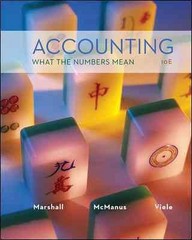Question
The formal definition of breakeven to when our total revenue equals our total costs, which gives us a zero profit. Break-even analysis is based on
The formal definition of breakeven to when our total revenue equals our total costs, which gives us a zero profit.
Break-even analysis is based on our knowledge of the behavior of costs.
Fixed costs are those costs which do not change from month to month, regardless of how busy we are. For example, the store rent is $1,500 per month, regardless of what our sales are for the month. If sales are $65,000, our rent is $1,500. If sales increase to $75,000, the rent is still $1,500. If our sales fall to $55,000, our rent is still $1,500 for the month.
Fixed costs are fixed in total, regardless of our level of activity.
Variable costs behavior just the opposite of fixed costs. Variable costs do change with our level of activity. For example, our wage expense is $4,000 per month when we sales are $65,000. When sales increase to $75,000, our wage expense increase to $4,500. And when sales fall to $55,000, our wage expense is $3,500.
Variable costs vary in total as our level of activity, usually measured in sales,vary.
Price The price is the amount we charge the customer for the product or service we are selling.Cost is what we pay for the item or service. Price is what we charge our customers for what we are selling.
Our formula to determine how many products we must sell in order to break even is simple.
Break-even quantity = Fixed Costs / (Selling Price - Variable Cost)
For example, if our fixed costs for the month are $100, and the selling price is $9 per unit, and the variable costs per unit is $4, our equation would like look:
Break-even quantity = $100 / ( $9 - $4)
So for this example, break-even quantity is 100/ 5 = 20 units.
Using our numbers from the example, subtracting the variable cost from the selling price gave us $5. We call that the unit contribution margin.
The unit contribution margin is the amount of the sale that "contributes" to covering or offsetting the fixed costs. Every time we sell the product, we have $5 to help cover the fixed costs.
So let's say we only sell 1 unit this month, let's calculate our net income.
Revenue 9
Variable Cost 4
Contribution Margin 5
Less Fixed Cost 100
Operating Profit (95)
Do you see how the contribution margin helps to cover the fixed costs? Let's look at a month in which we sell 10 units.
Revenue (10 x 9) 90
Variable Cost (10 x 4) 40
Contribution Margin (10 x5) 50
Less Fixed Cost 100
Operating Profit(50)
With more sales, we have more contribution margin to offset the fixed cost, which reduces our net loss
Now our formula, gave us a break even quantity of 20 units. Let's prove that true.
Revenue (20 x 9) 180
Variable Cost (20 x 4) -80
Contribution Margin (20x 5) 100
Less Fixed Cost 100
Operating Profit 0
Sure enough, our break-even formula was correct. So what happen to contribution margin when we have covered our fixed cost?
Let's see when we sell 21 units, one more than the break-even amount.
Revenue (21 x 9) 189
Variable Cost (21 x 4) -84
Contribution Margin (21x 5) 105
Less Fixed Cost 100
Operating Profit 5
Using the above data, what is the total contribution margin and the operating profit when we sell 41 units?
How did you determine your answers?
Step by Step Solution
There are 3 Steps involved in it
Step: 1

Get Instant Access to Expert-Tailored Solutions
See step-by-step solutions with expert insights and AI powered tools for academic success
Step: 2

Step: 3

Ace Your Homework with AI
Get the answers you need in no time with our AI-driven, step-by-step assistance
Get Started


